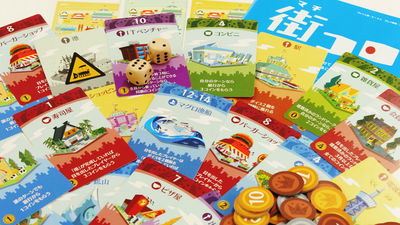A play review of the blockbuster board game ``Zoo Tycoon'' with a playing time of over 3 hours, in which you run a zoo while protecting and breeding animals and managing strict expenses.

The Japanese version of the heavyweight board game `` Zoo Tycoon '', in which you run your own zoo by arranging over 200 animal pieces and a large number of tiles on the board, appeared on September 28, 2023. Zoo Tycoon is a board game based on the zoo management simulation game of the same name released by Microsoft in 2001.Arklight Games provided us with the actual Japanese version, so four GIGAZINE editorial staff members actually created the game. I tried playing it.
Zoo Tycoon - ArclightGames Official
Zoo Tycoon is made up of a huge number of pieces, tokens, and cards, and it takes a lot of time to prepare for the first play. The contents of Zoo Tycoon and the preparation steps for the first play are summarized in the article below, so if you are playing for the first time, we recommend reading through it in advance.
Unboxing ``Zoo Tycoon'', a classic zoo management sim turned super heavyweight board game & summary of over 1 hour of play preparation - GIGAZINE

Zoo Tycoon repeats four rounds: spring, summer, autumn, and winter, and the player with the most victory points after managing the zoo for 7 years wins.
However, the first year of the game begins with the 'Animal Acquisition Phase' in the summer round .

The animal acquisition phase is processed starting from the player with the parent marker.

The order of processing is as follows. The process is performed once each counterclockwise from the player with the parent marker to the 4th player, and then once each clockwise from the 4th player.

As the name suggests, the animal acquisition phase allows you to acquire animals. If you look at the exchange board, each animal has a hole and a number is visible. For example, in the case of 'snow leopard' below, the green '1♂1♀' is displayed, which means that one male snow leopard and one female snow leopard can be supplied. The giant panda next to it is displayed with a red '1♂1♀', which means that there is a demand for one male giant panda and one female giant panda (described later). In this animal acquisition phase, you can get animals by placing your colored cubes on the animals that display green numbers that will supply animals.

Take out the animal piece you got from the box and place it in the 'Quarantine Station' on the left side of the zoo board. There are three levels of animals: Level I, Level II, and Level III. To obtain level II and level III animals, you must meet conditions such as ``already raising animals,'' but for level III animals, the conditions must be met only in the first animal acquisition phase. You can also obtain it.

Only two types of animals are allowed in the quarantine station at a time. Please note that you do not need to pay money to obtain the animals.

Once everyone has obtained an animal, the color cubes on the exchange board will be returned to their original state during the 'exchange board reset phase' and the game will move on to the fall round . However, the fall round of the first year starts with the 'construction phase'.

In the construction phase, place the 6 zoo tiles and quarantine station animals obtained in the preparation phase on the zoo board. Place tiles within the zoo grounds to create a 'biotope' and place one type of animal inside. However, there are conditions for placing animals, and you must meet the conditions of the animal card you have.
For example, in the case of the green-winged macaw below, up to two green-winged macaws can be placed on each tile in the garden. However, in addition to the tiles with animals placed on them, you must also place at least one tile without animals, two or more habitats with attention markers, and at least two animals in the biotope. Therefore, when choosing an animal in the animal acquisition phase, you should refer to the information written on the animal card at hand.

Each habitat marker costs 2 gold. Green-winged macaws require at least two habitats, so you will need to spend a total of 4 gold.

Once you have placed the animals in the park, place the colored cubes on top of the animal cards. This color cube shows the animal's happiness level, and increasing the color cube indicates whether the animals being bred are living happily. In addition, in the following cards, the color cube is placed in the second row from the bottom at the experience level (far left), but originally the color cube would be placed in the bottom row.
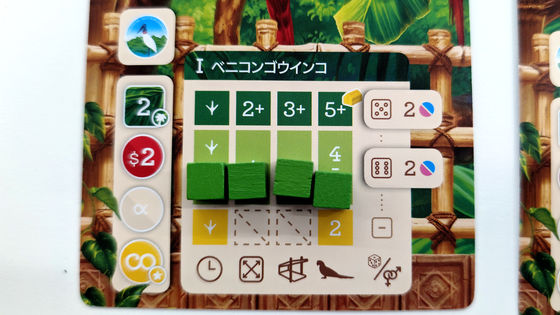
Also, apart from animals, you can place 'coexistence animal tiles' on empty tiles in the park.

If you place an animal or coexisting animal tile, you can get popularity. The number in the yellow star icon in the upper left corner is the popularity level. This time, you can get a total of 3 popularity, with 2 popularity for the green macaw and 1 popularity for the coexisting animal tile.

The popularity you get is measured by the color cube on the yellow popularity point meter on the evaluation board. Also, at the end of the construction phase, if any of the new animals added to the biotope during this round have a higher popularity base point than any other animal that was in the zoo from the previous round, your review points will be increased by that popularity base point. Add. For review points, place the review disc ahead of your color cube by an additional amount.

Furthermore, it is also possible to perform various effects and additional processing by using worker pieces. However, please note that there are only up to 3 worker pieces, and the second and subsequent pieces will cost 3 gold per person.

Once the construction phase is over, it's time to move on to the winter round .

During the animal breeding phase, the experience level of the animals placed in the zoo will be increased by one.
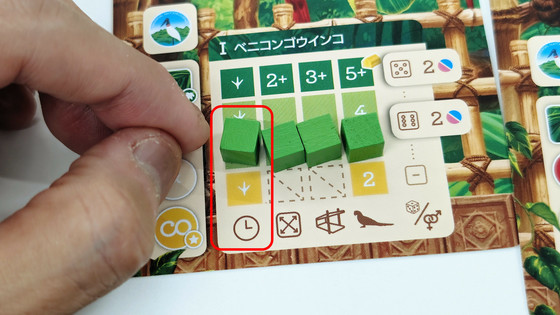
In the education points scoring phase, the player with the highest blue education points will receive one animal protection point. Education points can be obtained by building an education attention marker during the construction phase.

In the end, the winner of this game is the lower of the popularity points and animal protection points. In other words, you need to constantly increase both your popularity points and animal protection points.

In the tax phase that follows, if you currently have more than 3 gold, all the money in excess of 3 gold will be confiscated as tax. In short, everyone will be forced to have less than 3 gold. On the 3 gold scale, '$' is written on the gold meter.

And then there is the zoo's income and expenditure phase. Look at the popularity point meter and determine your income based on the position of the word-of-mouth disc. In addition, the player in first place will receive an additional 4 gold, and the player in second place will receive an additional 2 gold. For example, in the following case, the red player will earn 24 gold (20 gold + 4 gold), the yellow and blue players will earn 15 gold + 2 gold = 17 gold, and the green player will earn 10 gold.
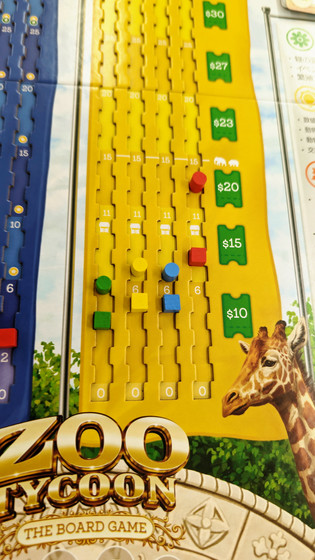
However, when running a zoo, there are not only income but also expenses. Expenses are determined by the number of animals kept in the zoo, the number of coexisting animal tiles, the cost of using worker pieces, etc., and calculate your expenses by moving the color cubes on the expense table.
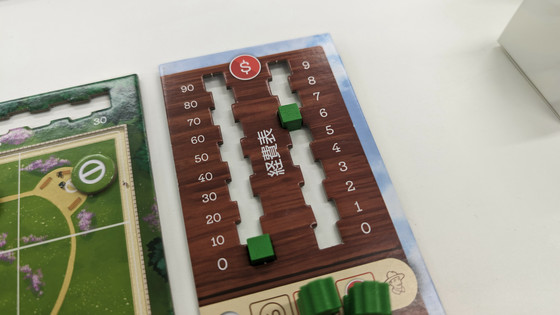
Subtract your expenses from your income to calculate how much money you have.

During the word-of-mouth point reset phase, the word-of-mouth disk will return to the 0 portion of the popularity point meter. Popularity points are permanent points, and once you get them, you never lose them, but word-of-mouth discs are points that are added only for that year. Therefore, review points are reset every year.
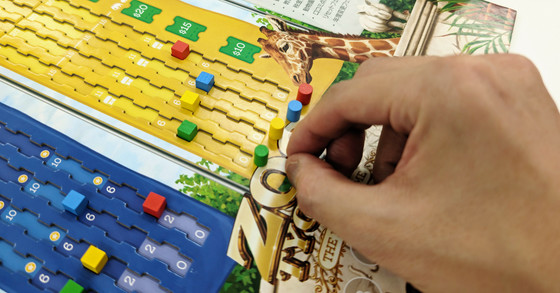
Next, return the used worker pieces to the worker piece storage area.
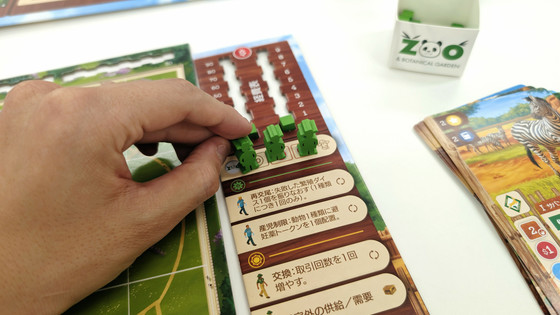
Then, advance the token in the year display by one year. The winter round is now over.
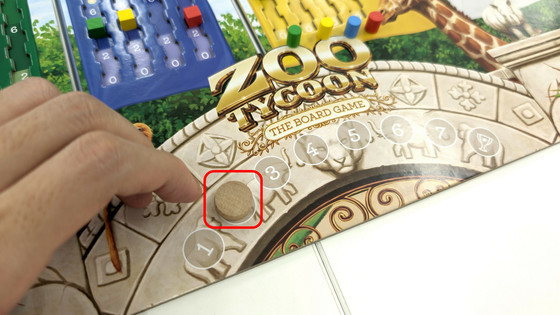
Next is the spring phase.
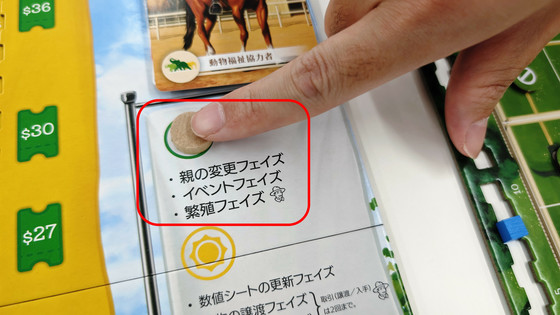
First, pass your parent's turn to the person to your right.
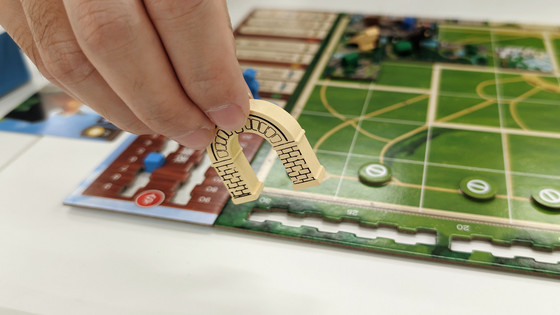
In the event phase, turn over and process the event card at the top right of the evaluation board. This time, the player with the lowest popularity score can get one tile in the park. You can get 3 tiles in the park at the beginning of the autumn round, and you can only draw one by paying 7 gold during the construction phase, so being able to get 1 tile in the park for free is quite valuable.

This time, the green player with the lowest popularity score was able to get one tile in the park.

Next is the breeding phase. Literally, this is the phase in which the animals in the zoo breed and have more children. However, all color cubes placed on the animal cards must be placed above the yellow-green area. In the case of the green macaw shown below, if you roll the dice and get 6 or more, two children will be born. There are two pairs of green-winged macaws, one male and one female, so when I rolled two dice, I got one 6.

Take two descendant markers from Hotei. If you successfully breed an animal, you will get the highest popularity point among the successfully bred animals.

If a level I or II animal in your zoo successfully breeds for the first time in the game, you will receive points for the World Animal Conservation Plan depending on its class. Please note that breeding animals must be processed for breeding if possible.
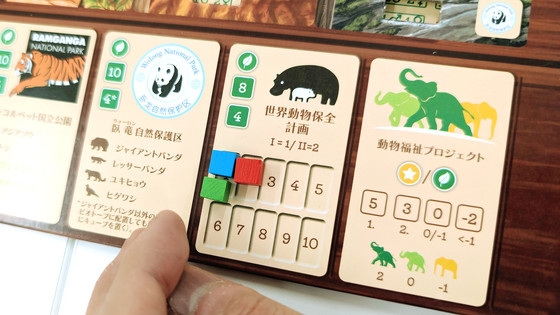
Level III animals cannot receive World Animal Conservation Program points.
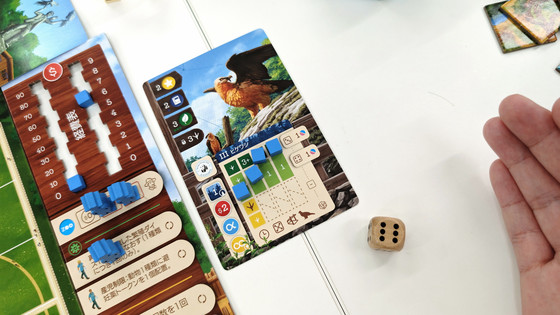
However, for level III, place color cubes on the exchange board. If you breed level III animals, you will get animal protection points.

In Zoo Tycoon, there is no benefit to breeding animals except for popularity and World Animal Conservation Program points. Rather, if a descendant marker remains at the end of the game, points will be deducted. The purpose of the zoo in Zoo Tycoon is 'to protect the animals on Earth,' and the manual states, 'Even if a particular animal becomes extinct in nature, as long as it remains in the zoo, it will be protected from complete extinction.' Because it can be saved.' In other words, the significance of the player is to breed independently of winning or losing the game.
Once the breeding phase is over, we move on to the summer round.
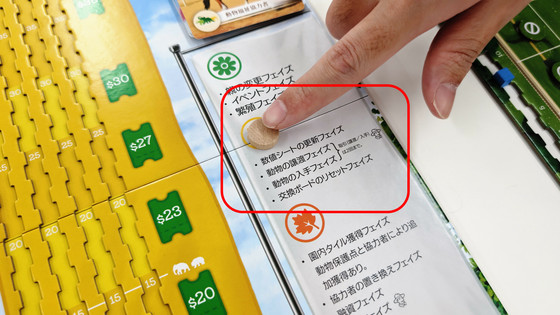
The first of the summer rounds deals with the update phase of the number sheets. Slide the replacement board according to the scale on the numerical sheet.
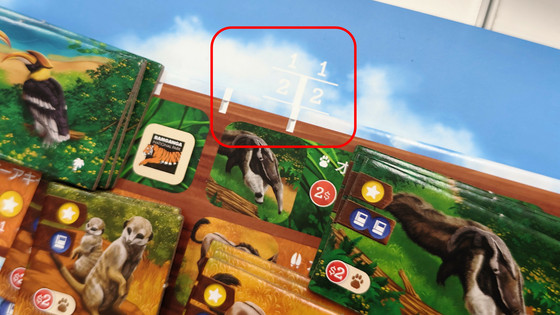
When you move the exchange board, the numbers displayed in the holes in the animal squares will change. The supply and demand for animals changes every year.
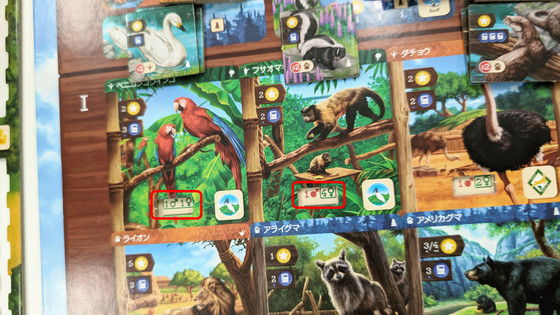
Then, after completing the animal transfer phase, animal acquisition phase, and exchange board reset phase, move on to the autumn phase.

In the 'Garden Tile Acquisition Phase', you can get any 3 tiles in the park. In addition, the player who has earned the most education points at this point and the player who meets the conditions of the collaborator card can get an additional tile.
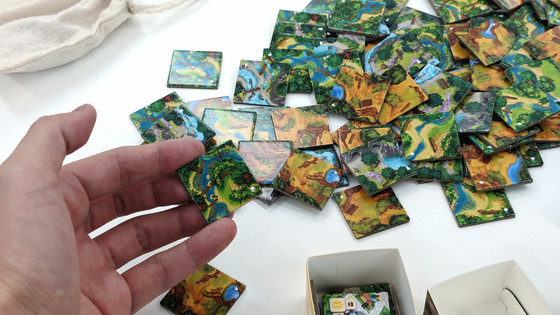
Collaborator cards will be updated in the 'Collaborator Replacement Phase'. This animal welfare collaborator card allows the player who has earned the most animal welfare points, which are calculated according to the happiness level of the animals they keep, to acquire an additional tile.

Next is the “loan phase”. At this point, players who have less than 9 gold can take out a loan of up to 4 gold as many times as they want. However, as a result of the loan, the amount of money you have cannot exceed 10 gold.
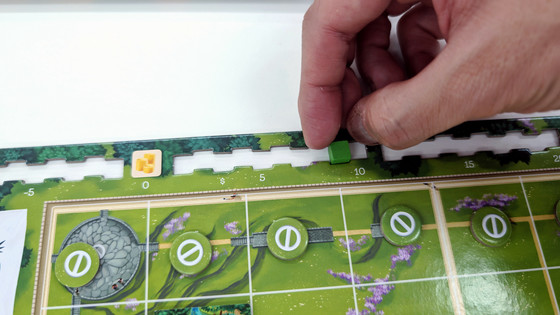
Also, each time you receive a loan, you must place one prohibited token on the zoo board square. Since you will not be able to place tiles in the zoo on squares where you place prohibited tokens, the more you receive financing, the smaller the area of the zoo that can be utilized will become smaller and smaller.
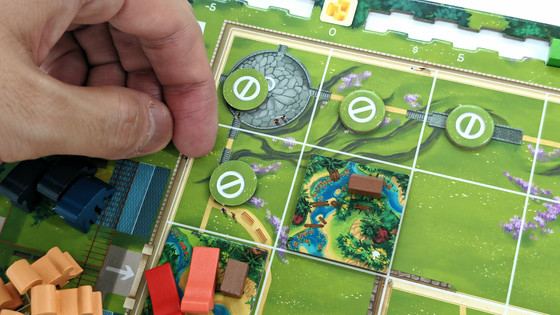
Then, in the ``Architecture Phase,'' we will enhance the zoo. In addition to the green macaw, the green player places a capuchin monkey and also places a giant anteater coexistence animal tile.
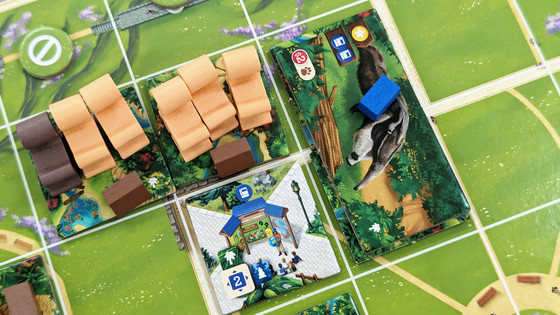
If you succeed in placing a specific combination of animals, you will be able to successfully 'partner with a national park' and get animal protection points.
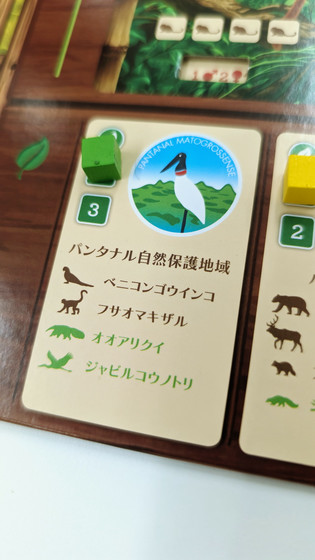
In this way, we will somehow develop the zoo by building buildings and welcoming new animals to the zoo.
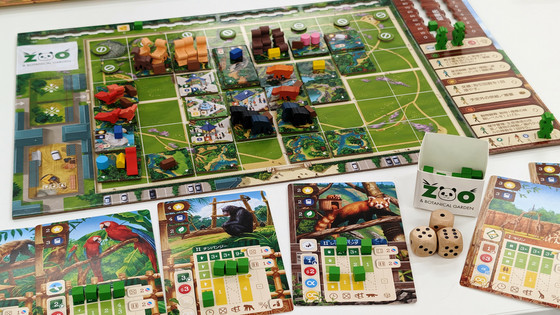
What about a zoo with only parakeets and monkeys? So, we got the popular giraffe here.
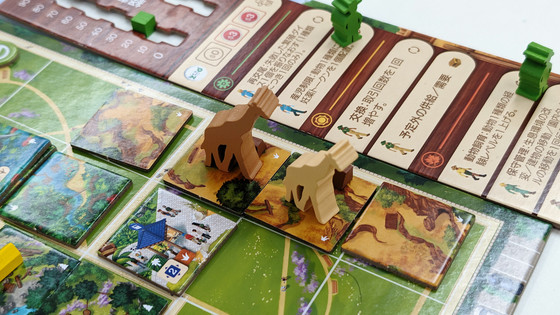
However, only one giraffe can be placed per tile in the park. Breeding cost is 3 gold per placed tile. In other words, if you are breeding two animals, there is a problem that the breeding cost will be as much as 6000 yen.
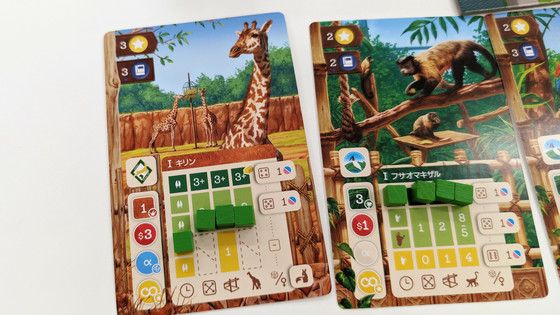
The more animals you place, the more expenses will increase. Of course, as the number of animals increases, the popularity points also increase, so the income also increases, but at the same time, the expenses also increase, so in the end, the money left in hand is around 10 gold, and all players are forced to suffer from bicycle operation. It will be.
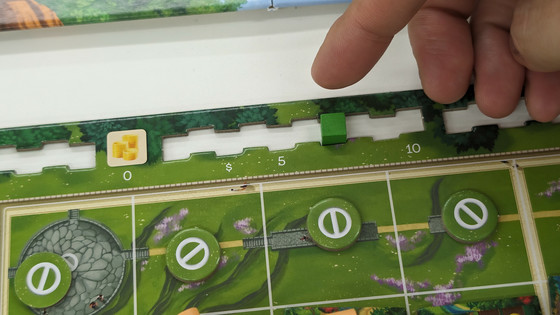
Once the 7th year winter round is over, we will make the final payment.
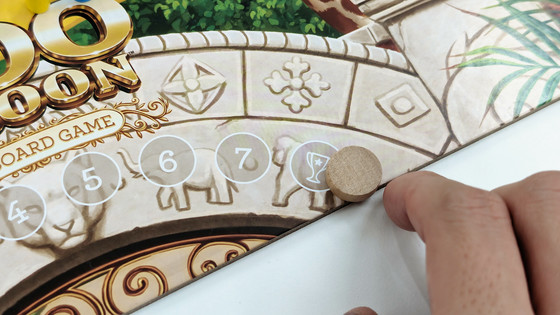
The final settlement will be done after using all the money you have, and the lower of the animal protection points (green) and popularity points (yellow) will be the victory points. This time, the blue player had the highest popularity points with 33 points and animal protection points with 32 points, and won with 32 victory points.
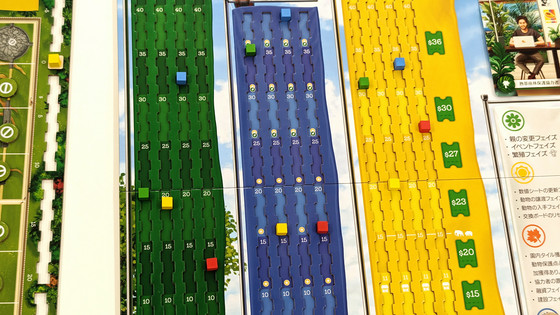
The zoo of the winning blue player looks like this. The big point was that I obtained a level III bearded eagle early on, successfully bred it quickly, and accumulated animal protection points. Furthermore, the reason for the victory was to raise popularity points at the same time by breeding six types of animals and placing building tiles.
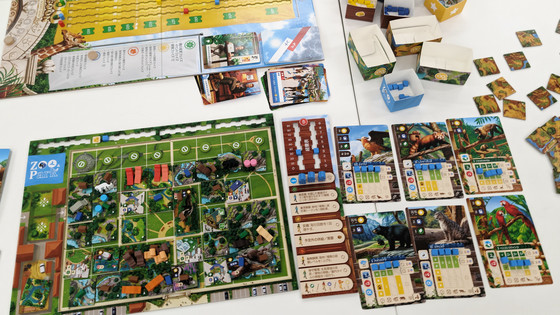
I played Zoo Tycoon with four people, and the first time I played it, including the instrumental, it took about 4 hours until the fifth year. The second time, everyone had a good grasp of the rules, so it took about 30 minutes per year, and it took about 3 and a half hours to play through to the end.
Zoo Tycoon is a complete information game where other players do not hide the information you need to make decisions. Although there are some aspects that are influenced by other people's management, the core of your play style is basically to focus on managing your own zoo. Therefore, the joy of creating ``your own zoo'' is great, and at the end of the game you will be able to say, ``I lost at my zoo, but there are giraffes, parakeets, and red pandas, so this zoo might be attractive if I were to go there.'' I have a feeling.
However, the rules are quite complex and the game takes a long time to play. There are many detailed restrictions such as ``If ○○, you must not do ○○'' and ``If XX, you must do XX.'' Even if you have a quick reference card at hand, it is difficult to refer to the rules. It is better to have a rule book at hand for each player so that the game can proceed smoothly. The official website publishes the Japanese version of the manual (PDF file) on the Internet, so it would be a good idea to print it out in advance and distribute it to everyone. Also, it is recommended that you play for a limited period of 2-3 years at first to understand the rules, but the rules are so detailed that it is difficult to fully understand them in one play. It can be said that it is difficult.
In addition, a fairly large space is required to arrange the exchange board, evaluation board, each player's zoo board, and boxes containing a large number of pieces and tiles, so even if they are arranged in a 2.4m x 1.0m space, it is quite narrow. . There are various management policies for zoos, and the strategy and replayability are very high, but as mentioned above, there is a lot of detailed processing and it takes time, so it is important to consult with the player's stamina if you want to play over and over again. Zoo Tycoon is a game with a lot of volume, so it is recommended for people who want weight and crunch in their games.
In addition, as of December 2023, Arclight Games has published a version of the manual (PDF file) based on the revised version and a list of errata containing corrections to the first edition Zoo Tycoon manual, so if you want to play, Please check in advance.
[Zoo Tycoon Errata List 231227]
https://arclightgames.jp/wp-content/uploads/2023/12/fa6a4165e64b95c1b73b2c9d63a5f8ea.pdf
The suggested retail price of Zoo Tycoon is 13,750 yen. It is also available on Amazon.co.jp and can be purchased for 10,500 yen at the time of article creation.
Amazon | Arclight Zoo Tycoon (1-4 players, 120-180 minutes, for ages 13 and up) Board Game | Board Game | Toys
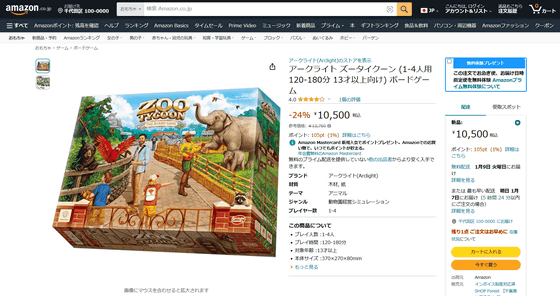
Related Posts:



